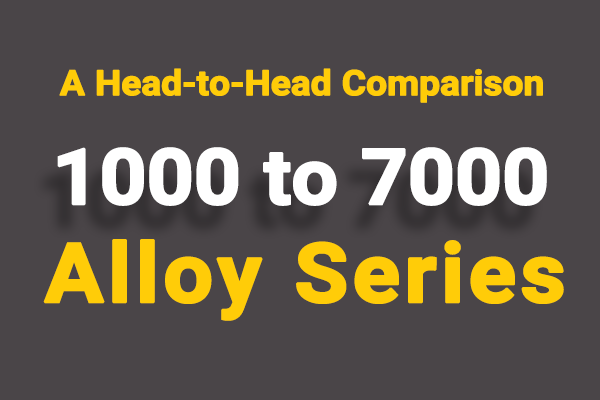To compare the different series of aluminum alloys (1000 through 7000), let’s explore each series in detail, focusing on variations, compositions, properties, advantages, disadvantages, and typical applications.
1000 Series Aluminum
Variations and Compositions:
- Main Alloying Element: Minimum 99% aluminum.
- Common Grades: 1050, 1100, 1200.
- Key Elements: High purity aluminum with trace elements such as iron and silicon.
Properties:
- Tensile Strength: Low (around 70-185 MPa).
- Corrosion Resistance: Excellent.
- Workability: Excellent, especially for deep drawing and spinning.
- Electrical Conductivity: High.
- Thermal Conductivity: High.
Advantages:
- Excellent corrosion resistance.
- High electrical and thermal conductivity.
- Good formability.
Disadvantages:
- Low strength compared to other aluminum series.
- Not suitable for high-stress applications.
Applications:
- Electrical conductors.
- Chemical equipment.
- Food and beverage packaging.
- Reflective surfaces.
2000 Series Aluminum Alloys
Variations and Compositions:
- Main Alloying Element: Copper.
- Common Grades: 2024, 2014, 2011.
- Key Elements: Aluminum, copper (typically 4-6%), and other elements such as manganese.
Properties:
- Tensile Strength: High (around 190-480 MPa).
- Corrosion Resistance: Poor, especially in marine environments.
- Workability: Good machinability but more difficult to form.
- Heat Treatable: Yes.
Advantages:
- High strength.
- Good machinability.
- Excellent fatigue resistance.
Disadvantages:
- Poor corrosion resistance.
- Requires protective coatings in corrosive environments.
Applications:
- Aerospace components.
- High-strength structural applications.
- Automotive components.
- Military equipment.
3000 Series Aluminum Alloys
Variations and Compositions:
- Main Alloying Element: Manganese.
- Common Grades: 3003, 3105, 3004.
- Key Elements: Aluminum, manganese (about 1-1.5%).
Properties:
- Tensile Strength: Medium (around 110-285 MPa).
- Corrosion Resistance: Good.
- Workability: Excellent, good formability and weldability.
- Heat Treatable: No.
Advantages:
- Good corrosion resistance.
- Good mechanical properties.
- Excellent workability.
Disadvantages:
- Moderate strength.
Applications:
- Beverage cans.
- Roofing sheets.
- Heat exchangers.
- Cooking utensils.
4000 Series Aluminum Alloys
Variations and Compositions:
- Main Alloying Element: Silicon.
- Common Grades: 4045, 4032, 4047.
- Key Elements: Aluminum, silicon (4-12%).
Properties:
- Tensile Strength: Varies widely.
- Corrosion Resistance: Good.
- Workability: Excellent, especially for casting.
- Heat Treatable: No.
Advantages:
- High wear resistance.
- Low coefficient of thermal expansion.
- Good corrosion resistance.
Disadvantages:
- Varies in strength.
- Limited to certain applications.
Applications:
- Welding wire.
- Automotive engine components.
- Heat exchangers.
- Brazing alloys.
5000 Series Aluminum Alloys
Variations and Compositions:
- Main Alloying Element: Magnesium.
- Common Grades: 5052, 5083, 5754.
- Key Elements: Aluminum, magnesium (up to 5%).
Properties:
- Tensile Strength: Medium to high (around 200-350 MPa).
- Corrosion Resistance: Excellent, especially in marine environments.
- Workability: Excellent.
- Heat Treatable: No.
Advantages:
- Excellent corrosion resistance.
- Good weldability.
- Good strength.
Disadvantages:
- Prone to stress corrosion cracking in certain conditions.
Applications:
- Marine environments.
- Pressure vessels.
- Transportation equipment.
- Architectural structures.
6000 Series Aluminum Alloys
Variations and Compositions:
- Main Alloying Elements: Magnesium and Silicon.
- Common Grades: 6061, 6063.
- Key Elements: Aluminum, magnesium (0.6-1.2%), silicon (0.4-1%).
Properties:
- Tensile Strength: Medium to high (around 150-350 MPa).
- Corrosion Resistance: Good.
- Workability: Good, excellent extrusion properties.
- Heat Treatable: Yes.
Advantages:
- Good corrosion resistance.
- Balanced strength and workability.
- Excellent for extrusions.
Disadvantages:
- Moderate strength compared to 7000 series.
Applications:
- Structural applications.
- Frames and pipelines.
- Automotive parts.
- Railings.
7000 Series Aluminum Alloys
Variations and Compositions:
- Main Alloying Element: Zinc.
- Common Grades: 7075, 7050.
- Key Elements: Aluminum, zinc (5-6%), magnesium, copper.
Properties:
- Tensile Strength: Very high (around 220-560 MPa).
- Corrosion Resistance: Moderate to good.
- Workability: Good machinability but more difficult to weld.
- Heat Treatable: Yes.
Advantages:
- Very high strength.
- Good fatigue resistance.
- Good machinability.
Disadvantages:
- Higher cost.
- More difficult to weld.
- Susceptible to stress corrosion cracking.
Applications:
- Aerospace structures.
- High-stress components.
- Sporting equipment.
- Military applications.
Summary Table
| Series | Main Alloying Element | Common Grades | Tensile Strength (MPa) | Corrosion Resistance | Workability | Heat Treatable | Key Applications |
|---|---|---|---|---|---|---|---|
| 1000 | Aluminum (99% min) | 1050, 1100 | 70-185 | Excellent | Excellent | No | Electrical conductors, food packaging |
| 2000 | Copper | 2024, 2011 | 190-480 | Poor | Good | Yes | Aerospace, military equipment |
| 3000 | Manganese | 3003, 3105 | 110-285 | Good | Excellent | No | Beverage cans, roofing sheets |
| 4000 | Silicon | 4045, 4032 | Varies | Good | Excellent | No | Automotive engine components, brazing alloys |
| 5000 | Magnesium | 5052, 5083 | 200-350 | Excellent | Excellent | No | Marine, transportation |
| 6000 | Mg and Si | 6061, 6063 | 150-350 | Good | Good | Yes | Structural applications, pipelines |
| 7000 | Zinc | 7075, 7050 | 220-560 | Moderate | Good | Yes | Aerospace, high-stress components |
This overview provides a detailed comparison of the 1000 to 7000 series aluminum alloys .

















No comment